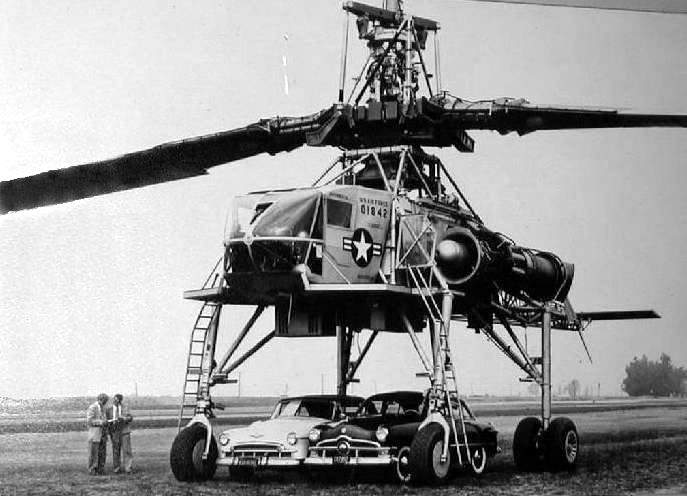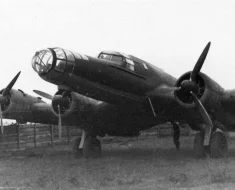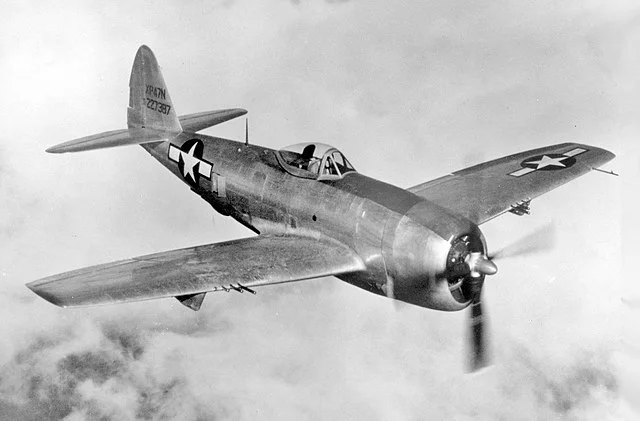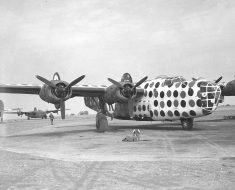During World War Two, the pace of technological change in military aviation was little short of staggering. One development brought something entirely new to the skies above the battlefield: the helicopter. Leading us to the story of the XH-17.
When the Second World War began, Britain, Russia, Italy, and the United States were all still using biplanes as front-line military aircraft. By the time that the war ended six years later, jet aircraft were beginning to explore transonic flight.
But by early 1943, the US Army Air Force (USAAF) placed an order for its first batch of Sikorsky R4 helicopters.
A little over a year later, a US Army lieutenant in Burma used one of those to carry out the first rescue of downed airmen in a combat zone. But those early helicopters were fragile, difficult to fly, and had very limited load-carrying capacity.

Which makes it all the more extraordinary is that, just three years after ordering their very first helicopters, the USAAF issued a specification for a jet turbine helicopter capable of lifting a payload of 5 tons!
Contents
Origin
The first rotary-wing aircraft operated by the US military wasn’t a helicopter but an autogiro. In 1935, the US Army Air Corps (USAAC) ordered the first of several KD-1 autogiros manufactured by the Kellett Autogiro Company.
Read More: Kaman K-MAX Helicopter – Function over Form
These were used in the battlefield observation role, and though they were never used in combat, they did illustrate the utility of a rotary-wing aircraft in military roles where the ability for short or even vertical take-off and landing was more important than speed or firepower.
The Kellett Autogiro Corporation had been founded in 1929 in Upper Derby, Pennsylvania by two pairs of brothers: Rodney and W. Wallace Kellett and Nicholas and C. Townsend Ludington.
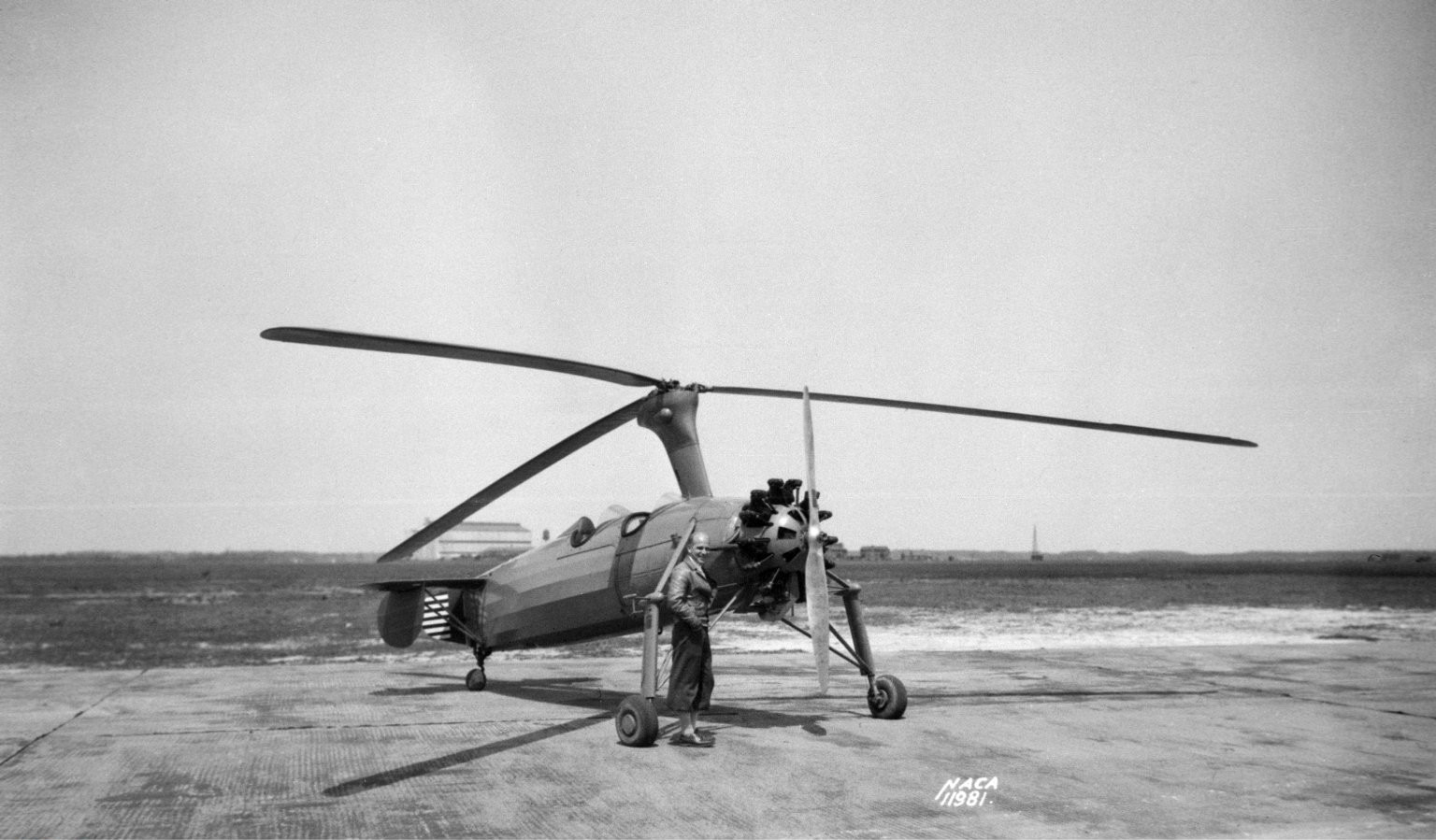
The company built versions of an autogiro based on the designs of Juan de la Cierva and Harold Pitcairn though it also developed and improved these basic designs. Kellett autogiros proved to be reliable and practical and were moderately successful.
In addition to being used by the USAAC, a Kellett autogiro was also used to initiate the first-ever rotary-wing air-mail service in the United States.
However, following the appearance in 1940 of the first practical helicopter in America, the VS-300 designed by Igor Sikorsky, Kellet changed direction to focus on the design and development of helicopters, being re-named the Kellett Aircraft Corporation in 1942.
In September 1943, Kellett was awarded a contract by the USAAF to build the prototype of a new helicopter that used twin, intermeshing main rotors, the XR-8.
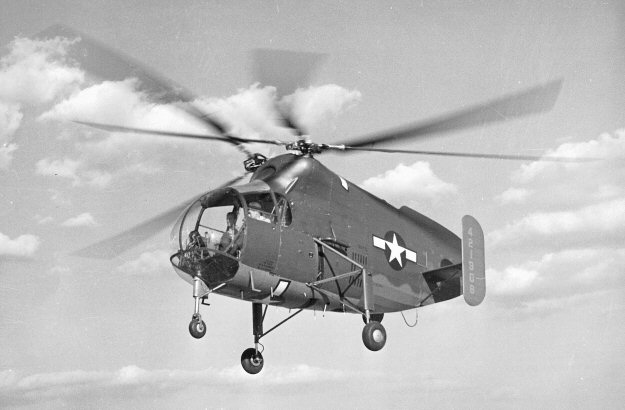
However, technical issues and budget cuts following the end of World War Two meant that neither this nor the subsequent and larger XR-10 ever advanced beyond the prototype stage.
However, these projects firmly established Kellett as one of America’s leading helicopter design companies. When the USAAF released a truly radical Request for Proposal for a heavy-lift helicopter in January 1946, it was no surprise that Kellett responded with a design proposal.
The Kellett XR-17
The USAAF Request for Proposal issued in January 1946 called for a helicopter powered by a jet turbine engine that included rotors with tip-jets and with the capacity to lift a payload of no less than 10,000lb.
Given that military helicopters were still in their infancy, this was a bold and forward-thinking specification for one of the world’s first military heavy-lift helicopters.
Kellett responded and, in May 1946, was awarded an initial design contract for what had been designated as the XR-17.
The design that Kellet presented was based around the use of a pair of General Electric J35 engines, the same engine that would be used in, amongst others, the Republic F-84 Thunderjet fighter bomber and the North American B-45 Tornado bomber.

However, in the XR-17 these engines would not be mechanically connected to the rotors. Instead, air from the engines would be bled off and vented through four pressure jets in the trailing edges of the tips of each of the two massive, hollow, main rotors. These rotors would span 130ft, the largest rotors ever fitted to any helicopter, before or since.
To further boost power, a pair of General Electric pressure-jet burners could be used to spray fuel into the jets of air emerging from the rotor tips. When ignited, this provided additional power in the same way that an afterburner does in a conventional jet aircraft.
Read More: Mil V-12 – The Biggest Helicopter Ever
It was estimated that these tip-burners would boost power from around 1,000hp to something in the region of 3,500hp, providing the power needed for heavy lift.
In August 1947, Kellett was awarded a contract to build a test rig to demonstrate the engine/rotor system, but by that time, the company was in serious financial difficulty. Progress on construction of the test rig proceeded very slowly and in late 1948, with the agreement of the USAAF, Kellett sold the heavy-lift helicopter project (which had now been re-designated as the XH-17) to the Hughes Aircraft Company.
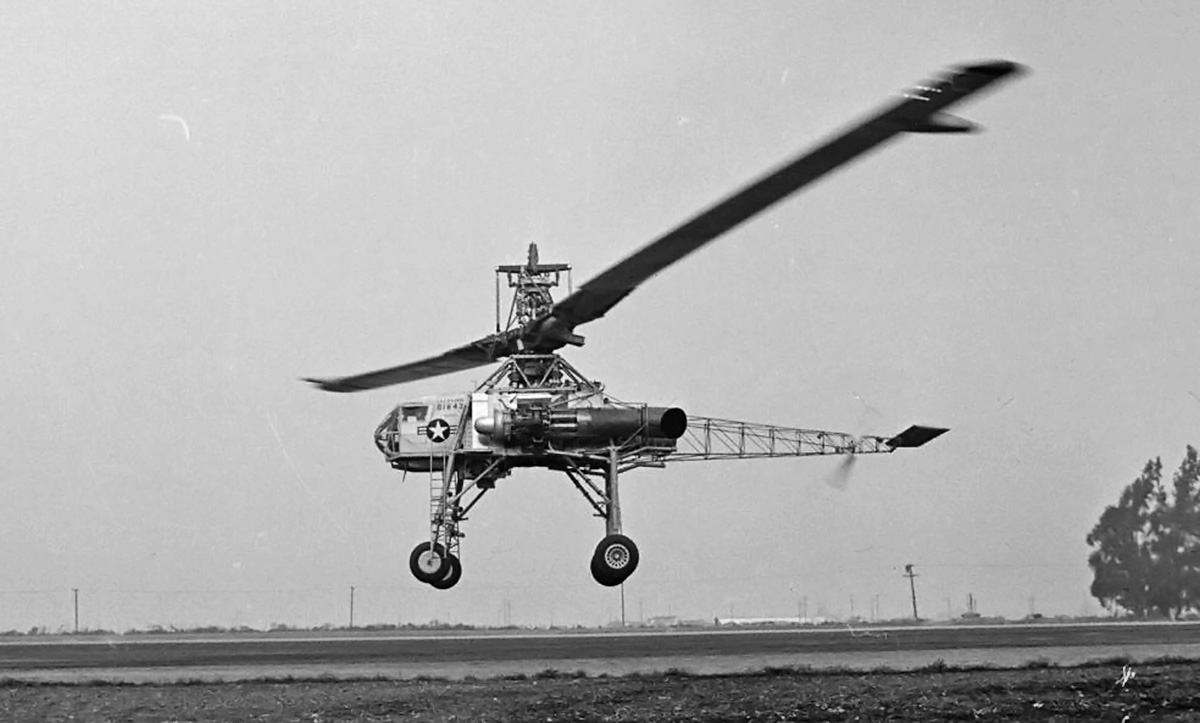
All completed parts and tools and several Kellett personnel were relocated to the Hughes Aircraft plant in Culver City, California. From this point on, the XH-17 would become solely a Hughes project (and the first helicopter design worked on by that company).
The Hughes XH-17
Hughes quickly began to build a complete airframe around the Kellett engine/rotor test rig. The fuselage was a simple tubular steel, open design and, to save time, many other components were re-used from existing aircraft.
The cockpit was taken directly from a Waco CG-15 glider, the four-wheel landing gear used parts from both the B-25 Mitchell bomber and the Douglas C-54 Skymaster and the fuel tank came from the B-29 Superfortress.
The widely-spaced, ungainly landing gear was purposely made very tall, allowing vehicles to drive under the helicopter to be secured for lifting. The engine and rotors were run for the first time in late 1949 and a major issue immediately became notable when the tip-rotors were ignited: noise.
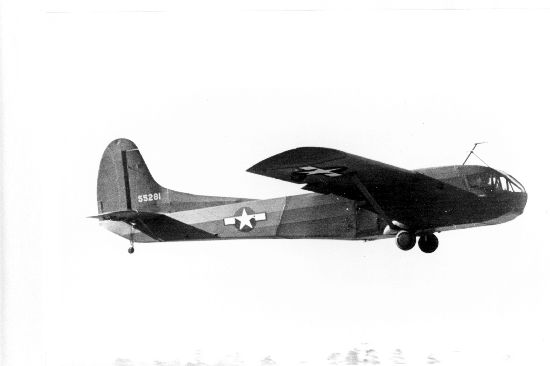
It was said that the sound of the rotors could be clearly heard more than eight miles from the Hughes plant and this resulted in the filing of a number of noise complaints against the company. Whatever it would become, it was clear that the XH-17 was never going to be stealthy!
In June 1950, it was decided to begin to prepare the helicopter for flight testing and one significant change was made: a tail rotor assembly from a Sikorsky H-19 Chickasaw helicopter was added to the tail of the fuselage.
The tip-jet design did not produce the torque forces associated with conventional helicopters so a tail rotor had not originally been included in the design. However, early static tests suggested that a small tail rotor would help with yaw control in the massive XH-17.
With this and other modifications complete, the XH-17 was declared ready for flight in October 1952.

Flight Testing
The XH-17 made its two, short first flights from Culver City on 23rd October 1952. It was found to be able to fly forwards (at up to 45mph), backward, to rotate through 360˚, and to land safely. There were no major issues with control and flight testing continued, with long pauses, over the course of three years. During this testing, the helicopter was able to reach a speed of 70mph in forward flight and successfully carried a load of 8,000lbs to an altitude of 350 feet.
However, it was also found to have a range of just 40 miles due to high fuel consumption. At this time, the XH-17 was the world’s largest helicopter and could carry a heavier load than any other: within Hughes, it became known as both the Flying Crane and The Monster.
But even as flight testing continued, it was clear that the USAAF was losing interest in the XH-17.
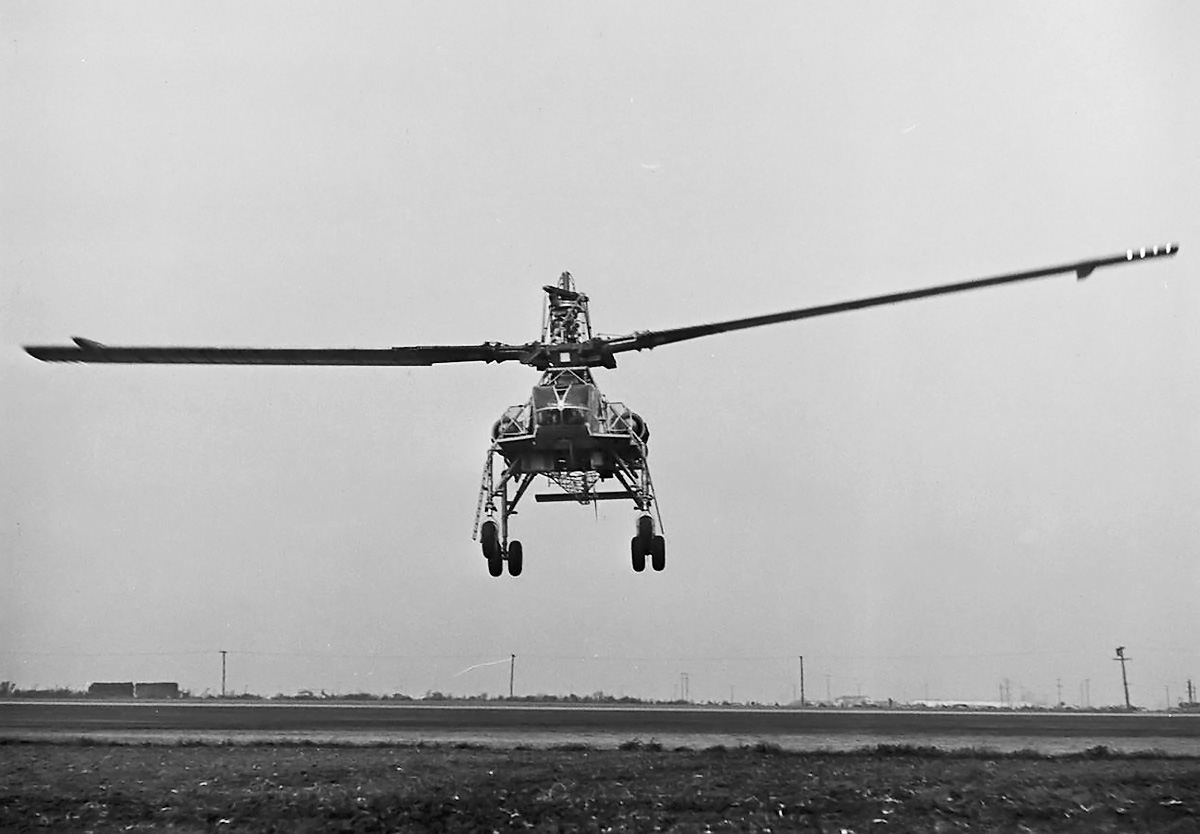
As early as October 1951, Hughes was asked by the USAF to consider an even larger version of this helicopter, given the designation XH-28.
This would use the same tip-rotor system, but would be powered by two linked pairs of Allison XT40-A-8 turboprop engines and was planned to be capable of lifting a staggering payload of 50,000lbs (25 tons!). It would also use bonded titanium rotors as the massive rotors of the XH-17 was found to have a relatively short fatigue life.
However, only a single mock-up of the futuristic-looking XH-28 was completed before the USAAF canceled both the XH-17 and XH-28 projects in August 1953.

Briefly, the US Army considered taking over both helicopter projects. The XH-28 would have allowed the rapid deployment of light tanks such as the M41 Walker Bulldog and other vehicles. But the US Army had already decided that instead, it would concentrate its resources on the development of smaller utility helicopters and it declined to become involved in either project.
Sporadic flight testing of the XH-17 ended in December 1955. By that time, and after a total of a little more than ten hours in the air, the main rotors were showing signs of fatigue cracking and would need replacement.
With no interest being shown by the US Army or Air Force, there seemed no point in this and the single XH-17 prototype and the XH-28 mock-up were subsequently scrapped.
Conclusion
The adoption of the Sikorsky CH-54 Tarhe (better known as the “Skycrane”) by the US Army in 1962 showed that the notion of a heavy-lift helicopter was valid.
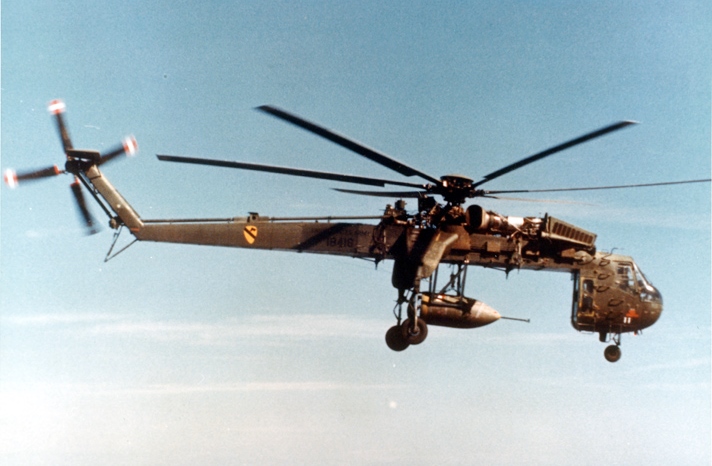
The CH-54 could lift a payload of up to 20,000lbs and it was used during the Vietnam War to recover downed aircraft and helicopters. But the CH-54 was of entirely conventional design, with its main rotor driven directly from two Pratt & Whitney T73-P-700 turboshaft engines.
What doomed the radical XH-17 and XH-28 was their radical tip-jet rotor system. This wasn’t just incredibly noisy; it was also grossly inefficient and used a great deal of fuel.
Read More: Lockheed SR-71 Blackbird – The Plane Designed to Leak
Conventional helicopters proved to be much quieter and a great deal more efficient. In retrospect, it’s easy to see that there was never going to be a role for a military helicopter with very short range and that could be heard by the enemy from many miles away, no matter how great a load it could lift.
I’m afraid that the XH-probably 17 belongs to the category of abandoned military aircraft designs headed: “It seemed like a good idea at the time…”
If you like this article, then please follow us on Facebook and Instagram.
Specifications
- Crew: 3 (pilot, mechanic and in-flight test engineer)
- Capacity: demonstrated loads up to 10,284 lb (4,665 kg) were carried
- Length: 53 ft 3.6 in (16.246 m)
- Height: 30 ft 1.2 in (9.174 m)
- Empty weight: 28,562 lb (12,956 kg)
- Max takeoff weight: 43,500 lb (19,731 kg)
- Powerplant: 2 × General Electric 7E-TG-180-XR-17A gas generators, 3,480 hp (2,600 kW) each combined predicted gas power output, with rotor turning at 88 rpm
- Main rotor diameter: 130 ft (40 m)
- Maximum speed: 90 mph (140 km/h, 78 kn) at 8,000 ft (2,438 m)
- Range: 30 mi (48 km, 26 nmi) with 10,284 lb (4,665 kg) payload
- Service ceiling: 13,100 ft (4,000 m)
- Rate of climb: 1,650 ft/min (8.4 m/s)

